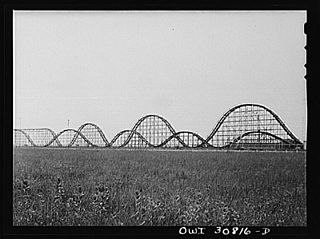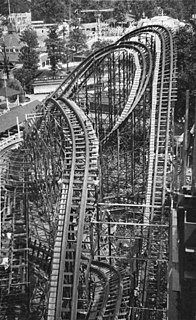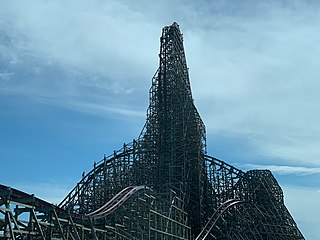
Playland, often called Rye Playland and also known as Playland Amusement Park, is an amusement park located in Rye, New York, along the Long Island Sound. Built in 1928, the 280-acre (110 ha) park is owned by the Westchester County government. Beginning with the 2018 season, Standard Amusements LLC has been contracted to operate the park.

A roller coaster train is a vehicle made up of two or more cars connected by specialized joints which transports passengers around a roller coaster's circuit.

American Coaster Enthusiasts (ACE) is a non-profit organization focusing on the enjoyment, knowledge, and preservation of roller coasters as well as recognition of some as architectural and engineering landmarks. Dues-paying members receive the quarterly magazine RollerCoaster! and bi-monthly newsletter ACE News. Amusement parks have also invited members to exclusive ride events at amusement parks as well as sneak peek events at new roller coasters under construction.
Harry Guy Traver was an American engineer and early roller coaster designer. As the founder of the Traver Engineering Company, Traver was responsible for the production of gentle amusement rides like the Tumble Bug and Auto Ride. However, Traver's coasters became legendary for their unique twisted layouts and thrilling, swooped turns. At a time when most coasters were built from wood, Traver was the first coaster builder to utilize steel for the primary structural material.
John A. Miller was an American roller coaster designer and builder, inventor, and businessman. Miller patented over 100 key roller coaster components, and is widely considered the "father of the modern high-speed roller coaster." During his lifetime, he participated in the design of approximately 150 coasters and was a key business partner and mentor to other well-known roller coaster designers, Harry C. Baker and John C. Allen.

The Crystal Beach Cyclone was one of a 'Terrifying Triplet' of highly extreme and intense roller coasters designed and built by Harry G. Traver in the late 1920s. The Cyclone was located at the Crystal Beach Park in Ontario, Canada.

The Cyclone was a wooden roller coaster that operated at Revere Beach in Revere, Massachusetts, from 1925 until 1969. When Cyclone was constructed, it was the tallest roller coaster ever built, as well as being the first roller coaster in the world to reach 100 feet (30 m) in height. In addition to being the tallest roller coaster of its day, some also claim that it was the largest and fastest roller coaster in the world, with a length of 3,600 feet (1,100 m) and top speeds between 45 and 50 mph. Cyclone held the title of world's tallest roller coaster until 1964 when it was surpassed by Montaña Rusa at La Feria Chapultepec Mágico in Mexico City, Mexico.
Frederick A. Church (1878–1936) was an American engineer and early roller coaster designer. He is most famous for his "Bobs" series of roller coasters that featured severe banking, steep drops, and nonstop action.
Harry C. Baker was an American entrepreneur most notable for his involvement with the construction of roller coasters. Through partnerships and later, as president of the Harry C. Baker Company, Baker would be involved with notable designs such as the Cyclone at Coney Island, the Blue Streak at Woodcliffe Pleasure Park, and Jack Rabbit at Kennywood.
Vernon Keenan was an American roller coaster designer best known for his involvement with the Cyclone at Coney Island.

Playland Park was an amusement park located in Houston, Texas operating between 1940 and 1967. Louis Slusky opened Playland Park circa 1940 at 9200 South Main. It is popularly remembered for its wooden roller coaster, The Skyrocket. Texas' first elevated monorail train (1956) briefly operated near the park. Next to the park was an adjoining stock-car race track known as Playland Speedway. Slusky also facilitated the miniature children’s train located in Houston’s Hermann Park. This train may have originated from Playland Park. Playland Park closed in 1967.
Jazz Railway was an early model line of wood roller coasters incorporating a steel-frame structure. These operated at various amusement parks and fairgrounds during the mid to late 1920s. The coaster model is considered to be the first of the Wild Mouse style roller coaster.

The Sesquicentennial Cyclone was a steel-framed wooden roller coaster which was operated at the Philadelphia Sesquicentennial Exposition in 1926. Designed and built by Harry Traver of Traver Engineering, the coaster was a medium-sized prototype of Traver's later Giant Cyclone Safety Coasters.

Cyclone was the name of two wooden roller coasters which operated at Palisades Amusement Park in Bergen County, New Jersey, United States. The first operated from 1927 through 1934, and the second between 1945 and 1971.
Zip or Zipp was a steel-framed wooden roller coaster which operated at Oaks Amusement Park in Portland, Oregon. The coaster was a more compact variant of the Giant Cyclone Safety Coasters which were built by Harry Traver of the Traver Engineering Company in the mid to late 1920s.

Thunderbolt was a wooden roller coaster which operated at Savin Rock Amusement Park in West Haven, Connecticut, from 1925 until 1938 when it was destroyed by a hurricane. It was rebuilt in modified form in 1939 and it continued to operate until 1956. When it was first built, it was purported to be the fastest roller coaster in the world.
Giant Cyclone Safety Coasters were a model line of roller coasters designed and marketed by Harry Traver and his company Traver Engineering in the 1920s. Despite their name, they had a reputation of being dangerous and are regarded by many historians as some of the most fearsome roller coasters ever built.

Cannon Coaster, sometimes known as Leap-the-Gap, was a wooden roller coaster which operated on Bowery Street in Coney Island, Brooklyn, New York, in the first decade of the 20th century.

Drop the Dip, later known as Trip to the Moon, was a wooden roller coaster that operated at several locations in Coney Island, Brooklyn, New York, in the early 20th century. The coaster is considered by some to be the first truly high-speed roller coaster.

A hybrid roller coaster is a category of roller coasters that is defined as having the track made out of steel, while the support structure is made from wood. Though less common, this can also be flipped around, with the track made of wood with a steel running plate, and a support structure that is made of steel. An example of this is The Voyage at Holiday World. The wooden frame-steel track design of roller coaster is mostly known to be utilized by Rocky Mountain Construction in their I-Box track design, and Arrow Dynamic's Mine Train style roller coasters.











